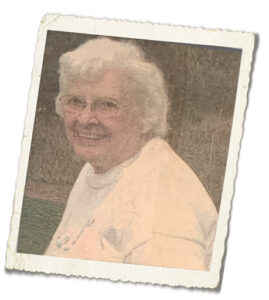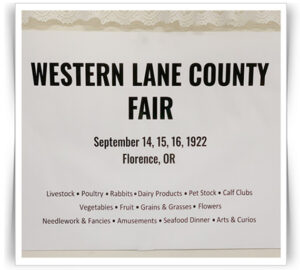ALMA TATOM
Oral History Project
Ed and Alma Tatom were interviewed together in 1976 and Alma was interviewed for a second time in 1994. They were long-time residents of the Florence area and made significant contributions to their community. Everyone felt fortunate to have known them.
 Alma Tatom took a liking to cows early in life. In 1913 her parents Henry and Pearl (Woosley) Holden had a homestead up the North Fork of the Siuslaw River. It was 7 miles from Florence. While a schoolgirl, she milked her family’s 7 cows before walking a mile to Portage school. When her neighbor across the river was away, Alma milked their 9 cows before going to school as well. Portage was a one-room schoolhouse, which she attended until the 8th grade.She once described her school as being “one room, with one teacher who taught grades one through eight. So, we taught each other somewhat. I actually started teaching school in the 6th grade.”
Alma Tatom took a liking to cows early in life. In 1913 her parents Henry and Pearl (Woosley) Holden had a homestead up the North Fork of the Siuslaw River. It was 7 miles from Florence. While a schoolgirl, she milked her family’s 7 cows before walking a mile to Portage school. When her neighbor across the river was away, Alma milked their 9 cows before going to school as well. Portage was a one-room schoolhouse, which she attended until the 8th grade.She once described her school as being “one room, with one teacher who taught grades one through eight. So, we taught each other somewhat. I actually started teaching school in the 6th grade.”
Her father worked as a logger. Sadly, Henry Holden died in a logging accident near their home in 1929 when Alma was nearly 14. After his death, her mother and 6 younger siblings worked extra hard to keep the farm in the family. Chores were divided up, and in addition to milking the cows, Alma helped raise her 3 sisters and 3 brothers. Her sisters cooked and also helped raise the younger children. With a productive garden, and canning as much as they could, they were never without food. To do her chores, Alma learned to use the milk separator. The skim milk was fed to the calves and pigs, and the cream was sold to the Eugene Farmers Creamery. Her mother received $86 a month in benefits for her husband’s death. Alma remembers that flour, sugar and coffee were about the only items they purchased.
Alma Meets Ed Tatom
When Alma was 6, she had a tooth pulled by Ed’s father, (the first dentist in town). She could see Ed and his twin brother outside the window making faces at her the whole time. It wouldn’t be considered a friendly nor favorable first impression. Years later, Ed courted her while she attended Siuslaw High School.
Alma married Ed Tatom in 1931 when she was 16. In the early years, Ed was a packer at the cannery, worked on boats and was also a fisherman. Alma often claimed he was good at clam digging, and that his bounty was sold for “spare money”. In 1935 he worked as a guard on the Siuslaw Bridge for 18 months.
Ed became the Florence Police Chief in the early 1940’s. In 1945, they moved to Newport. Ed worked as a patrolman for a few months prior to becoming the Police Chief there for 10 years. While in Newport, Alma was the clinic chairman for the Western Lane Health Association. She worked at the monthly child health clinic assisting with examinations and smallpox shots. After Ed retired, they returned to Florence and lived on 160 acres in the Sutton Lake area with their 5 children.
Tragically, in 1956 their oldest son Edwin Ernest, Jr. died at age 24 when his car went over a steep embankment on North Fork Road.
The family moved to Canada in 1964 and enjoyed living there while Ed worked as a fire lookout. After 5 years, he was forced to retire due to his failing eyesight. He eventually became blind for 5 months. Miraculously, his eyesight was restored following a procedure in Florida. They returned to Oregon.
Homestead farming required hard work each day and made for a somewhat isolated family  lifestyle. In the 1900’s, the population of the Siuslaw Valley began to increase. The growth brought development of produce and dairy farms, fish canneries, and the logging industry. The North Fork Grange began in about 1912 and served as both a social and community association. Members united to address and improve schools, roads, and ways to reduce farm costs (such as livestock feed discounts). Other concerns were telephone and electrical service for the area, better mail service, “anything that would benefit us”. The Grange also jointly sponsored the annual Western Lane County Fair in Florence for many years. In viewing the historical list of North Fork Grange Masters, it is evident women and men held equal membership roles. Alma took on leadership as the Master of the Grange in 1984-85.
lifestyle. In the 1900’s, the population of the Siuslaw Valley began to increase. The growth brought development of produce and dairy farms, fish canneries, and the logging industry. The North Fork Grange began in about 1912 and served as both a social and community association. Members united to address and improve schools, roads, and ways to reduce farm costs (such as livestock feed discounts). Other concerns were telephone and electrical service for the area, better mail service, “anything that would benefit us”. The Grange also jointly sponsored the annual Western Lane County Fair in Florence for many years. In viewing the historical list of North Fork Grange Masters, it is evident women and men held equal membership roles. Alma took on leadership as the Master of the Grange in 1984-85.
The Grange Hall was locally built, owned by community members, and of significant social importance. It became a social center and anchor for the community. Classes such as sewing, child rearing and food preservation were also taught. Events at the hall included dances, suppers, and a chance for social interaction. Each gathering was highly anticipated. For pot lucks, Alma Tatom was known as the “Lemon Pie Lady”. According to her, “summer or winter, any occasion was [an] excuse for a celebration, regardless of the weather.” . . . .”[As] a kid, my folks took me to dances at the old Grange Hall . . . we didn’t stay home because of rain.”
Besides the North Fork Grange, Alma was an active and theatrical performing member of the John Quay Heritage Players. She was a volunteer with the Rebekahs Lodge, the original Pioneer Association which started the Siuslaw Pioneer Museum. She became a highly respected museum docent.
Alma stayed on the family farm until she moved to town in 1995. For her, the past is a reminder of where we came from, and a lifestyle that brings good memories.
“I look back – we might have gone to town once a year as kids, we didn’t go often. Yes, we had a wonderful life, the Grange Hall was the center of all activities. We went to school, we had Christmas programs at the Grange Hall. . . . To me this is the life.”
Alma Tatom summed up the life on her parents’ farm as “a beautiful time in my life. We lived in the best of days.” And that is perhaps the best memory one can have.
